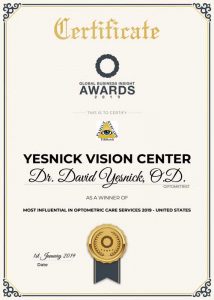 January marks a significant time in the eye health community — Glaucoma Awareness Month. Glaucoma, often called the "silent thief of sight," is one of the leading causes of vision loss and blindness. This month, we aim to raise awareness about this condition and highlight the vital low-vision services offered by Dr. Sandy Yesnick at Yesnick Vision Center in Las Vegas, the only dedicated low-vision therapist in Nevada.
January marks a significant time in the eye health community — Glaucoma Awareness Month. Glaucoma, often called the "silent thief of sight," is one of the leading causes of vision loss and blindness. This month, we aim to raise awareness about this condition and highlight the vital low-vision services offered by Dr. Sandy Yesnick at Yesnick Vision Center in Las Vegas, the only dedicated low-vision therapist in Nevada.
Understanding Glaucoma and Its Impact
Glaucoma is a group of eye diseases that damage the optic nerve, essential for good vision. A build-up of pressure in the eye causes glaucoma. Unfortunately, it often develops slowly and often without noticeable vision loss at first. This is why we emphasize the importance of regular eye exams, especially for those at higher risk.
Types of Glaucoma
We can categorize glaucoma into several types, each with its own characteristics and treatment approaches.
- Primary Open-Angle Glaucoma: This is the most common form, which progresses slowly and is often asymptomatic in its early stages. It’s typically caused by a gradual blockage of the drainage canals in the eye, leading to increased intraocular pressure (IOP).
- Angle-Closure Glaucoma: Though less common, a sudden and complete blockage of the drainage canals causes angle-closure glaucoma. It is considered a medical emergency and can lead to rapid vision loss.
- Normal-Tension Glaucoma: Occurs despite normal eye pressure, suggesting other factors like reduced blood flow to the optic nerve.
- Secondary Glaucoma: Results from another eye condition or disease.
- Congenital Glaucoma: This type is rare and affects infants and young children.
Risk Factors for Glaucoma
Understanding the risk factors for glaucoma is essential for early detection and effective management. Some of the key risk factors include:
- Age (people over 60 are at higher risk)
- Ethnicity (African Americans, Asians, and Hispanics are more at risk)
- Family history of glaucoma
- Certain medical conditions like diabetes, hypertension, and heart disease
- Eye conditions like high intraocular pressure, thin corneas, or severe nearsightedness.
Regular eye exams are particularly important for those falling into these risk categories, as glaucoma often progresses without noticeable symptoms until significant vision loss has occurred.
Symptoms of Glaucoma
Despite being known as the “silent thief of sight,” some forms of glaucoma, like acute angle-closure glaucoma, may exhibit symptoms like severe eye pain, nausea, redness in the eye, blurred vision, and seeing halos around lights.
For other types, gradual loss of peripheral vision, often in both eyes, is a common symptom. As the disease progresses, the central vision may decrease until it leads to blindness.
The Role of Low Vision Services in Glaucoma Management
While there is no cure for glaucoma, and the vision loss it causes is irreversible, there are ways to manage its impact on daily life. This is where Yesnick Vision Center steps in with our specialized low-vision services. We aim to help individuals with glaucoma and other vision impairments maintain their independence and quality of life.
- Personalized Low Vision Aids: We provide a variety of aids, from magnifiers to electronic devices, all designed to cater to different levels of vision loss.
- Vision Rehabilitation: Our programs focus on enhancing the remaining vision of our patients. Dr. Yesnick's expertise ensures that each rehabilitation plan is as unique as the patient receiving it.
- Education and Support: Understanding glaucoma and living with low vision can be challenging. Our team offers continuous education and support to patients and their families.
Schedule a Low Vision Consultation in Las Vegas
With the dedicated expertise of Dr. Sandy Yesnick and our commitment to personalized care, we stand as a leader in low-vision therapy in Nevada.

